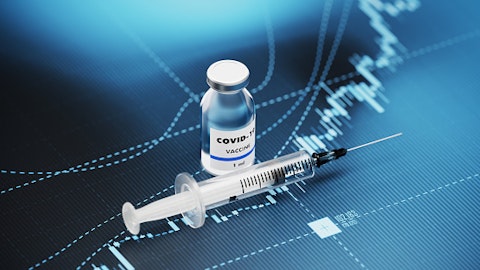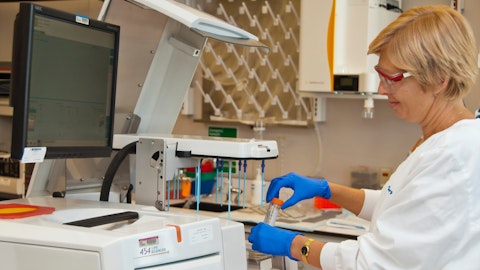Vertex Pharmaceuticals Incorporated (NASDAQ:VRTX) Q3 2023 Earnings Call Transcript November 6, 2023
Vertex Pharmaceuticals Incorporated beats earnings expectations. Reported EPS is $3.97, expectations were $3.92.
Operator: Good day and welcome to the Vertex Pharmaceuticals Third Quarter 2023 Conference Call. All participants will be in a listen only mode. [Operator Instructions] After today’s presentation, there will be an opportunity to ask questions. Please note this event is being recorded. I would now like to turn the conference over to Ms. Susie Lisa. Please go ahead, ma’am.
Susie Lisa: Good evening all. My name is Susie Lisa, and as the Senior Vice President of Investor Relations, it is my pleasure to welcome you to our third quarter 2023 financial results conference call. On tonight’s call, making prepared remarks, we have Dr. Reshma Kewalramani, Vertex’s CEO and President; Stuart Arbuckle, Chief Operating Officer, and Charlie Wagner, Chief Financial Officer. We recommend that you access the webcast slides as you listen to this call. The call is being recorded and a replay will be available on our website. We will make forward-looking statements on this call that are subjects to the risks and uncertainties discussed in detail in today’s press release and in our filings with the Securities and Exchange Commission.
These statements, including without limitation, those regarding Vertex’s marketed cystic fibrosis medicines, our pipeline, and Vertex’s future financial performance are based on management’s current assumptions. Actual outcomes and events could differ materially. I would also note that select financial results and guidance that we will review on the call this evening are presented on a non-GAAP basis. In addition, the impact of foreign exchange is presented inclusive of our foreign exchange risk management program. I’ll now turn the call over to Reshma.
Reshma Kewalramani: Thanks, Susie. Good evening all, and thank you for joining us on the call today. We’ve delivered another strong quarter and continue to drive execution across the company. By reaching more CF patients, third quarter global product revenue grew 6% versus the prior year period and we are raising full year 2023 CF product revenue guidance to approximately $9.85 billion. We are delivering on our marketed medicines in CF, while simultaneously preparing for commercial excellence in multiple areas ahead of our potential near-term launches, including exa-cel in both severe sickle cell disease and transfusion dependent beta thalassemia, VX-548 for acute pain and longer term in peripheral neuropathic pain, and our vanzacaftor triple combination therapy for cystic fibrosis.
Most notably, we are tracking towards an exa-cel PDUFA date for sickle cell disease on December 8th of this year and for TDT on March 30th of next year, with global regulatory reviews also underway in Europe and the UK. Phase 3 pivotal trial readouts in early 2024 from both our vanzacaftor triple NCF and our VX-548 program in acute pain, a Phase 2 trial readout by year end 2023 from our VX-548 trial in diabetic peripheral neuropathy, and completion of enrollment in the Phase 2 portion of the VX-147 Phase 2/3 program in AMKD later this year. With that overview, let me now turn to a pipeline update, starting with cystic fibrosis. For our next in class vanzacaftor triple combination therapy, we remain on track to complete all three Phase 3 studies, SKYLINE 102 and SKYLINE 103 in patients ages 12 years and above and the RIDGELINE study in patients ages 6 to 11 by the end of 2023 and share results from these three pivotal studies in early 2024.
We have high expectations that the vanzacaftor triple combination can deliver greater improvements in CFTR function than TRIKAFTA based upon the totality of evidence generated to date, including in vitro from our HBE assays and in Phase 2 studies. The vanzacaftor triple holds the potential for enhanced clinical benefit versus TRIKAFTA for patients and the convenience of once daily dosing. It also carries a substantially lower royalty burden. In addition, we continue to make progress with another important program in our CF portfolio, VX-522, our CFTR mRNA therapy in development with our partners at Moderna for the more than 5,000 CF patients who cannot benefit from CFTR modulators. We continue to expect to complete the single ascending dose portion and initiate the multiple ascending dose portion of this study by the end of the year.
Turning now to exa-cel, our CRISPR/Cas9 based gene editing program for sickle cell disease and transfusion-dependent beta thalassemia. This program holds the potential to be a one-time functional cure for these debilitating and life-shortening diseases. Exa-cel represents an enormous advancement for the estimated 32,000 people living with severe sickle cell disease and transfusion dependent beta thalassemia across the U.S. and Europe. It is a large commercial opportunity. On the regulatory front in the U.S., we were very pleased to have had the chance to discuss the exa-cel filing with members of the FDA advisory committee last week, and to hear the very compelling stories from patients. The meeting represented a significant milestone for Vertex and the first potential CRISPR/Cas9-based therapeutic.
We look forward to our upcoming PDUFA date and to the potential of bringing this precise, durable gene editing therapy to patients. Internationally, in both the UK and the EU, we are also well into the regulatory review process and expect regulatory decisions in these jurisdictions in the coming months. In addition, we recently submitted a marketing authorization application for exa-cel to the Saudi Food and Drug Authority, or SFDA. I am pleased to share that exa-cel is the first medicine ever to receive breakthrough designation by the SFDA, reflecting both the high unmet need and the high enthusiasm for exa-cel in the Kingdom of Saudi Arabia. We look forward to updating you in the coming months. Moving on to the pain program and VX-548, our novel, highly selective NaV1.8 inhibitor that holds the promise for effective pain relief without the side effects or addictive properties of opioids and therefore represents a significant commercial opportunity in both acute and neuropathic pain.
The pace of the Phase 3 program in acute pain has been rapid, which we see as an indication of the high unmet need and strong patient and physician interest in an efficacious non-opioid acute pain therapy. We have completed the randomized control trial in abdominoplasty. The RCT in bunionectomy and a single-arm safety and efficacy study remain on track to complete by the end of this year. As previously discussed, we will unblind, analyze, and share results on all three studies at the same time, and we expect to do so in early 2024. This comprehensive Phase 3 program has been designed to support a broad, moderate to severe acute pain label, and to enable prescribing and usage across multiple care settings. We’re also studying VX-548 in peripheral neuropathic pain, or PNP, yet another area of high-end met need.
Recall, we previously demonstrated positive proof-of-concept with the predecessor molecule, VX-150 in neuropathic pain. In diabetic peripheral neuropathy or DPN, I am pleased to share that we have completed our Phase 2 12-week dose-ranging proof-of-concept study. We anticipate sharing the results from this Phase 2 trial by the end of this year. As we await the DPN results, we are excited to initiate a second Phase 2 peripheral neuropathic pain study of VX-548 by the end of the year in lumbosacral radiculopathy or LSR. It’s a type of neuropathic pain caused by the impairment of nerve roots in the area of the lumbar spine. Given the limited therapeutic options, the significant opportunity to serve a large number of patients and the promise that the NaV1.8 mechanism holds, we are excited to pursue the potential of VX5-48 in each of these neuropathic pain types.
Next, on to type 1 diabetes, where we are evaluating stem cell derived, fully differentiated, insulin producing islet cells for people with type 1 diabetes. Our goal is to develop a potential one-time functional cure for the millions of people living with type 1 diabetes, including the more than 2.5 million patients in North America and Europe alone. The VX-880 or naked cell program, where we have already established proof-of-concept is foundational to the type 1 diabetes program as a whole. Here, patients take standard immunosuppressants to protect the islet cells from the immune system. At EASD last month, we presented positive updated clinical data from all patients in Parts A and B of the VX-880 study. With regard to study status, Part C of the study, which administers the full target dose with concurrent dosing is now fully enrolled.
Our second program, VX-264, or the cells + device program, encapsulates these same cells in a proprietary immunoprotective device and hence there is no requirement for immunosuppressants. We have begun enrollment and dosing in Part A of the VX-264 study. And finally, our third program, still in the research stage is our hypoimmune cells, in which we edit the same fully differentiated cells so as to obviate the need for immunosuppressants. Transitioning now to inaxaplin or VX147, the first potential medicine to target the underlying cause of APOL1-mediated kidney disease or AMKD. The inaxaplin pivotal program for Patients with AMKD is a single adaptive Phase 2/3 study with a pathway to accelerated approval in the U.S. The Phase 2b, dose ranging portion of the study, continues to enroll in dose patients, and we expect a complete enrollment by the end of this year.
We now expect to select a dose and move to Phase 3 of the study in Q1 of 2024. Now turning to alpha-1 antitrypsin deficiency or AATD. We have discontinued development of VX-864 due to non-serious rash events in some patients in the Phase 2 program. Our next generation molecules, VX-634 and VX-668, both have greater potency and better drug-like properties and are both in Phase 1 clinical trials. These trials continue to enroll and dose healthy volunteers. We look forward to sharing more on AATD, including next steps, as we learn more in the coming months. With that, I’ll turn it over to Stuart.
Stuart Arbuckle: Thanks, Reshma. I will focus my remarks tonight on CF, exa-cel, and pain. We delivered strong third quarter commercial results with CF product revenue growing 6% globally versus the prior year, as we continue to reach patients in younger age groups as a result of new regulatory approvals and via new reimbursement agreements. Our strategy in CF has always been to develop medicines for all people living with CF and to serially innovate to deliver increased clinical benefit. We will continue to execute near term with a focus on younger age groups. And then our goal is to drive growth over the medium term with the vanzacaftor triple combination and longer term with our mRNA program, VX-522, that we are developing in partnership with Moderna.

Now turning to exa-cel, our next targeted launch and potential multi-billion dollar opportunity. This quarter I will provide some insights as to launch readiness ahead of potential near-term regulatory approvals, and then detail the patient journey. In the U.S. and Europe, we’ve previously highlighted that there are approximately 32,000 eligible patients with severe disease, 25,000 with sickle cell disease, and 7,000 with beta thalassemia. The majority of sickle cell disease patients are in the U.S., while the majority of TDT patients are in Europe. Within Europe, approximately 75% of all eligible patients live in four countries, the U.K., France, Italy, and Germany. Italy has by far the highest prevalence of eligible TDT patients, while France and the UK represent the majority of eligible patients with sickle cell disease.
In the US and Europe, we are on track with our globally enabled supply network and launch preparations with authorized treatment centers and payers, including our recently completed application for a new technology add-on payment, or NTAP, for Medicare patients in the U.S. In addition, Reshma mentioned our exa-cel MAA submission in the Kingdom of Saudi Arabia or KSA. Our team is engaging with the Saudi health authorities and working on the processes to support ATC activation, access and reimbursement with the aim of bringing exa-cel to the thousands of patients with severe disease in KSA. We look forward to providing you with more information on future calls about this important additional opportunity. As we prepare for approval and launch, it is important to understand the exa-cel patient journey, which can be broken down into three key phases, each of which can take several months.
First, pretreatment. Initially, when a potential exa-cel patient and their hematologist decide the therapy is right for them, the patient is then referred to a transplant physician at an ATC. Once that referral is scheduled, the patient then undergoes a full workup to determine whether they are fit for treatment with exa-cel. Second, cell collection and manufacturing. This phase involves mobilization to move the blood stem cells from the bone marrow into the peripheral blood, where the cells can be collected through apheresis. The patient’s cells are then sent to our manufacturing facilities, where they are edited and then tested for quality control. Cell collection takes longer for sickle cell disease patients given the need for two months of red blood cell transfusions prior to mobilization and on average two rounds of mobilization and apheresis.
In contrast TDT patients do not require pre mobilization transfusions and typically only require one round of mobilization and apheresis. The final phase is treatment. Once the edited cells are ready, the patient starts the treatment phase, which includes myeloablative conditioning, infusion of the edited cells, at which point we will recognize revenue for the therapy, and then waiting for engraftment and post-infusion care. A critical timing factor in this phase is the patient’s preferred timing for treatment, as they must choose a time that works best for their lives, given that this step involves an approximate one month hospital stay. This patient journey is consistent across all geographies. Given the multiple steps and the duration of the journey, we expect 2024 to be a foundational year for exa-cel, as the first patients begin this journey and Vertex works to deliver transformative patient outcomes with the possibility of a lifetime of benefit.
Shifting now to VX-548, a highly selective NaV1.8 inhibitor for pain. Given the program’s rapid pace of clinical advancement, we have developed our go-to-market strategies and are actively planning for a potential near-term launch. I’d like to share an outline of some of the work we’ve done to size each market opportunity. Overall, the pain opportunity is massive. In the U.S. alone, each year, more than 90 million patients are treated for acute or peripheral neuropathic pain. Both acute and PNP are each multi-billion dollar markets today, despite the fact that essentially all prescriptions are generic. And we see additional upside to these opportunities given the challenges of currently approved treatments. The unmet need in pain stems from the suboptimal benefit risk profiles of existing agents, such as the adverse effects and addiction potential of opioids and the lack of consistent efficacy for anticonvulsants like the gabapentinoids prescribed for neuropathic pain.
We believe the innovation of VX-548 and its overall profile could provide a transformative option for millions of patients. In acute pain, we estimate approximately 80 million patients are prescribed a medicine for their moderate to severe acute pain every year in the US. More than two-thirds of patients receive acute pain treatment driven by an institution, either during a hospital or ambulatory surgery center visit or at discharge. As hospital-driven prescribing is concentrated amongst some 2,000 hospitals and 200 IDNs, we can reach a large proportion of the patient opportunity with a specialty sales force. As Reshma mentioned, the peripheral neuropathic pain study in DPN is completed and the LSR study is about to begin. PNP is an exciting commercial opportunity given that approximately 10 million patients are prescribed a medicine for a PNP condition every year in the US, with chronic dosing, but limited treatment options.
PNP fits our Vertex specialty model perfectly. PNP is a collection of chronic conditions in which nerve impairment causes pain. DPN and LSR are two of the largest patient segments. LSR represents over 40% of all PNP patients, while DPN represents approximately 20% of all PNP patients. Specialists play a critical role in treating PNP, as patients can be on multiple treatments and are often in search of more effective pain control, given the limited therapeutic options. Therefore, we believe the PNP segment is addressable with a specialty sales force, and we look forward to bringing innovation to PNP patients. In conclusion, it’s an exciting time at Vertex. We continue to make progress treating more CF patients, and are on the verge of bringing a potential functional cure to patients with sickle cell disease or beta thalassemia with exa-cel.
We’re also preparing for multiple additional near-term launches, including the vanzacaftor triple in CF and VX-548 in acute pain, both of which have the potential to dramatically improve patients’ lives and represent significant market opportunities for Vertex. I will now turn the call over to Charlie to review the financials.
Charlie Wagner: Thanks, Stuart. Vertex’s excellent results in the third quarter of 2023 demonstrate once again our consistent strong performance and attractive growth profile. Third quarter 2023 revenue increased 6% year-over-year to $2.48 billion. U.S. Revenue grew 7% year-over-year following the recent FDA approval of TRIKAFTA in patients ages two to five, and outside the US revenue grew 6% year-over-year on continued strong uptake of TRIKAFTA/KAFTRIO in markets with recently achieved reimbursement as well as label extensions in younger age groups. As anticipated, in Q3 we saw the drawdown of inventory in certain international markets in contrast to the increases in inventory that we experienced in the first half of the year.
Year-to-date revenue of $7.35 billion represents 11% growth over the corresponding prior year period, including an approximate $150 basis point headwind from changes in foreign currency. Overall, the primary drivers of revenue growth in 2023 have been in line with our expectations. Third quarter 2023 combined non-GAAP R&D, acquired IPR&D and SG&A expenses were $993 million compared to $758 million in the third quarter of 2022. Q3 2023 results include $52 million of acquired IPR&D charges compared to $29 million of such charges in the third quarter of 2022. Operating expense growth was driven, as expected, by continued investment in research and our pipeline. Throughout 2023, the most significant areas of increased investment versus prior year included the clinical studies for VX-548 in acute pain, the vanzacaftor triple in CF, and for type 1 diabetes, as well as build out of capabilities for our expanding pipeline.
In addition, we continued our pre-commercial activities for exa-cel and other anticipated near-term launches. Third quarter 2023 non-GAAP operating income was $1.17 billion compared to $1.29 billion in the third quarter of 2022. Third quarter 2023 non-GAAP earnings per share were $4.08, representing 2% growth compared to $4.01 in the third quarter of 2022. We ended the quarter with $13.6 billion in cash and investments. Our priorities for cash deployment remain unchanged as we continue to prioritize investment in innovation, including external innovation via business development. Year-to-date, we have completed nearly 10 transactions with total consideration of over $500 million. We’ve also continued to allocate cash to share repurchases, and year-to-date, we have spent approximately $285 million to repurchase approximately 900,000 shares.
Now switching to guidance. Given our strong year-to-date results and our consistent execution, we are increasing our 2023 revenue guidance as detailed on Slide 17. For the full year 2023, we now expect CF net product revenue of approximately $9.85 billion versus our prior range of $9.7 billion to $9.8 billion. Note that this revenue guidance continues to include an expected approximate $150 basis point headwind to our revenue growth rate from changes in foreign currency. We are maintaining our 2023 guidance for combined non-GAAP R&D, acquired IPR&D and SG&A expenses in a range of $4.1 billion to $4.2 billion. We continue to invest a majority of our operating expenses into R&D, given the momentum in our multiple mid and late-stage clinical development programs.
We are also funding the expansion of our commercial capabilities in anticipation of the multibillion-dollar opportunities represented by our programs with near-term launch potential, while continuing to leverage an attractive business model afforded by our focus in specialty markets. Due to an increase in our current year U.S. R&D tax credit estimate, we are lowering guidance for our projected full year 2023 non-GAAP effective tax rate by 100 basis points to a range of 20% to 21% versus the prior range of 21% to 22%. In closing, Vertex delivered excellent results yet again in Q3 2023, achieving strong revenue growth, important regulatory milestones, continued clinical trial progress, and ongoing investments both internally and externally. As we continue to advance our programs to close out 2023 and head into 2024, we anticipate further important milestones as highlighted on Slide 18 to mark our continued progress in multiple disease areas.
We look forward to updating you on our progress on future calls and I’ll ask Susie to begin the Q&A period.
See also Top 12 Lead Producing Countries in the World and 13 Best Vanguard Funds for Retirement.
Q&A Session
Follow Vertex Pharmaceuticals Inc / Ma (NASDAQ:VRTX)
Follow Vertex Pharmaceuticals Inc / Ma (NASDAQ:VRTX)
Operator: We will now begin the question-and-answer session. [Operator Instructions] And the first question will come from Geoff Meacham with Bank of America. Please go ahead.
Geoff Meacham: Good afternoon everyone. Thanks so much for the question. [Technical Difficulty]
Susie Lisa: Hey, Jeff? Jeff, sorry. You are garbled. We can’t understand you. How about we go to the next one and come back to you? Yeah, that’s better. Thanks.
Geoff Meacham: Yep. So, first question on AAT. It seems like a much more difficult indication than initially thought. At a high level, what would you characterize that as? Is it just a mechanism? Is it the bar for risk-benefit? Or is it the molecules itself? And the second question is, when you look to vanzacaftor in the data, maybe help us with how rapidly you think you could roll reimbursement out across Europe and OUS indications. I know I wasn’t sure if this was part of your portfolio agreements or if you had to renegotiate that. Thank you.
Reshma Kewalramani: Yeah, sure. Thank you. This is Reshma. Let me break that into two questions. I’ll take the first part on AAT and I’ll ask Stuart to comment on the vanzacaftor and our plans for launching globally. Goeff, the particular issue with the VX-864 molecule in AATD is a non-serious rash. That’s it, that’s what it is. And when you see this, it’s almost always molecule specific. So no, it’s not the mechanism of action. This is where the portfolio strategy is really important and comes into play. VX-634 and VX-668, which are the next two molecules, they remain in Phase 1 development and we’re looking forward to getting those results. And the data event will be a 24-day event when we get to see those results and select a molecule or molecules and settle on next steps. Let me turn it over to Stuart to talk about vanza and to clarify the study is a global study and the intent is for global regulatory submissions and for a global launch. Stuart?
Stuart Arbuckle: Yeah, Geoff, so on expectations for access and reimbursement outside of the US. As Reshma said, importantly, this study is a head-to-head comparison with TRIKAFTA. To your specific question, was vanzacaftor imagined when we embarked on some of our portfolio agreements? It was. Some of them do include clauses to include increasingly better and better medicines which is our anticipation of what vanzacaftor will prove to be. It isn’t in all of our reimbursement agreements, just to be clear. But if the product can deliver the kind of profile that we expect, I would expect like we did with TRIKAFTA that we will beat the kind of industry benchmarks for getting to access patients across ex-US markets.
Geoff Meacham: Thank you guys.
Operator: The next question will come from Robyn Karnauskas with Truist Securities. Please go ahead.
Robyn Karnauskas: Thanks, guys. It sounds like 2024, 2025, it’s going to be a breakout year for Vertex transformatives in many ways. Two questions for me. One on pain, Reshma, thanks for clarifying and blinding at the same time. But we could all use investor questions saying, are you have concerns about the [abductomy] (ph) trial? Maybe help us understand a strategy for why doing that at the same time and if there’s any risks? My second question is on TNP. So you said you’ll have a specialty sales force. How do you market it in the context that Lyrica exists, even though it’s now a scheduled drug, maybe set expectations for what you’re looking for for that data? Thanks.
Reshma Kewalramani: Yep. Robyn, two questions on VX-548. One on the acute pain side and one on the neuropathic pain side. Let me tackle acute pain and I’ll ask Stuart to comment on our commercialization approach on the neuropathic side. So to ground everyone, the acute pain program is in its entirety three pivotal trials. One is the abdominoplasty RCT, the second is the bunionectomy RCT, and the third is a single arm safety and effectiveness trial. And the reason we are planning to unblind, analyze, and share the results all at the same time is because our goal is to secure a broad, moderate to severe acute pain label. And in order to do that, we need the results from all of these trials. So that’s the reason for sharing the results all at the same time.





